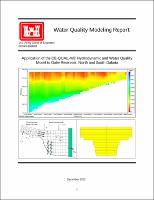Please use this identifier to cite or link to this item:
https://hdl.handle.net/11681/48273| Title: | Water Quality Modeling Report : Application of the CE-QUAL-W2 Hydrodynamic and Water Quality Model to Oahe Reservoir, North and South Dakota |
| Authors: | United States. Army. Corps of Engineers. Omaha District |
| Keywords: | Water quality--Mathematical models Hydrodynamics--Mathematical models Computer simulation Oahe, Lake (S.D. and N.D.) Environmental management Environmental protection |
| Publisher: | United States. Army. Corps of Engineers. Omaha District. |
| Abstract: | A priority water quality management need identified by the Omaha District (District) is the capability to quantifiably assess, with acceptable uncertainty, the affects that operation and regulation of the six Missouri River Mainstem System (Mainstem System) projects have on water quality of the Missouri River and the impounded reservoirs (USACE, 2013). To meet this need, the District developed a plan to apply the CE-QUAL-W2 Hydrodynamic and Water Quality Model (W2) to the six Mainstem System reservoirs: Fort Peck (Montana), Garrison (North Dakota), Oahe (North and South Dakota), Big Bend (South Dakota), Fort Randall (South Dakota), and Gavins Point (South Dakota and Nebraska). The District is approaching application of the W2 model to the Mainstem System reservoirs as an ongoing, iterative process. Water quality data is collected at the reservoirs and the model is applied and calibrated. The goal is to have linked, fully-functioning water quality models in place for all the Mainstem System reservoirs that meets the uncertainty requirements of appropriate decision-makers. W2 is a “state-of-the-art” model that can greatly facilitate addressing water quality management issues at the Mainstem System projects. W2 mechanistically models basic physical, chemical, and biological processes such as temperature, nutrient, algae, dissolved oxygen, organic matter, and sediment relationships. Once applied and calibrated, the model can reliably predict reservoir water quality conditions based on changes in environmental conditions or project operations and regulation. The ability to reliably predict reservoir water quality conditions under different environmental, operational, and regulation situations will allow the District to determine if water quality at specific projects may be impacted by project operations and regulation. As such, the model will allow the District to proactively assess how proposed project operations and regulation may affect water quality, and allow appropriate water quality management measures to be identified and implemented. |
| Description: | Technical Report |
| Rights: | Approved for Public Release; Distribution is Unlimited |
| URI: | https://hdl.handle.net/11681/48273 |
| Appears in Collections: | Technical Reports |
Files in This Item:
| File | Description | Size | Format | |
|---|---|---|---|---|
| CE-QUAL-W2 Report - Oahe Reservoir_2013.pdf | 8.97 MB | Adobe PDF |  View/Open |